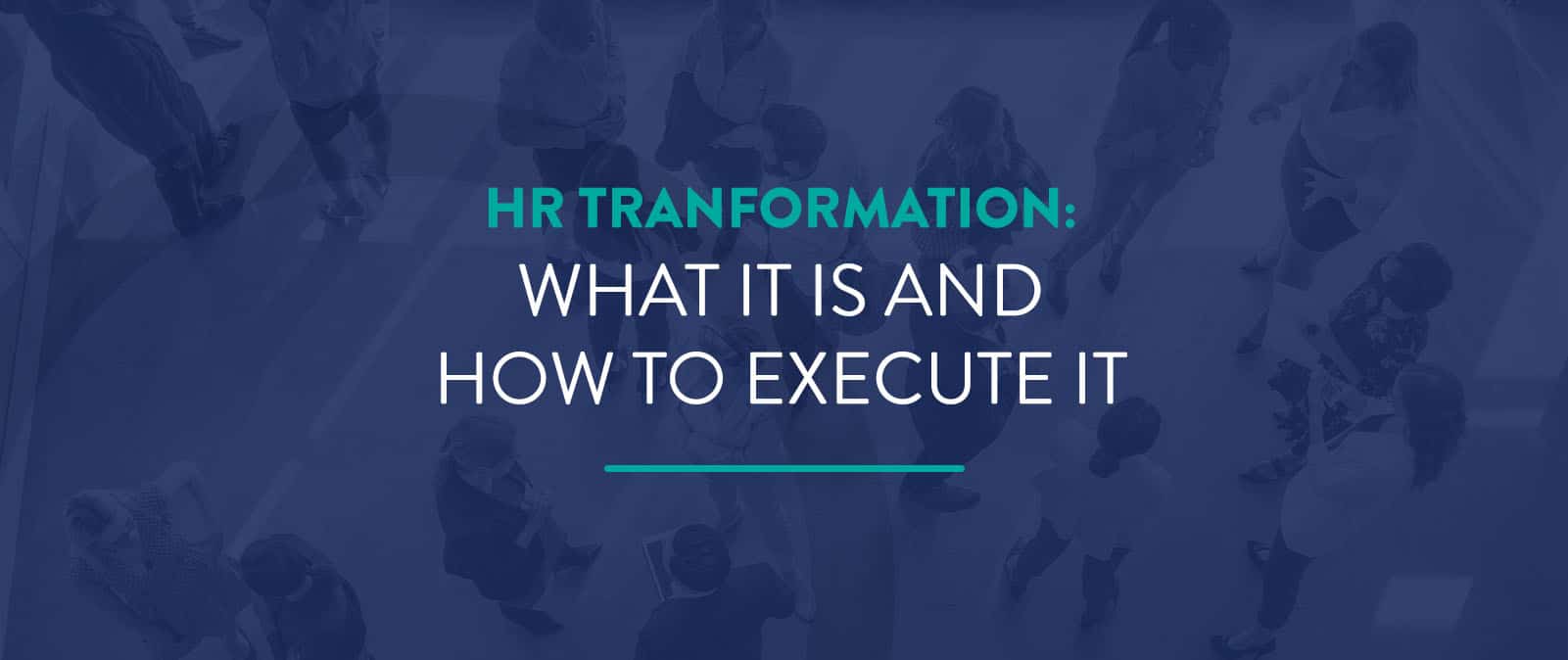HR Transformation: What It Is and How to Execute It

With an unpredictable economy, demographic changes and technological advancements hitting businesses today, it’s essential that HR systems evolve to keep up with the times.
Fundamental transformation requires ongoing improvement. HR departments should partner with their businesses and make internal advancements rather than only focusing on what customers and investors need them to deliver.
With a successful transformation, HR function becomes a tool for maintaining a solid workforce and achieving business goals. Understand the benefits of HR transformation and how you can achieve it for your business.
What Is HR Transformation?
HR transformation is a redesign of the HR department that involves wide-sweeping efforts rather than incremental changes. Instead of focusing on minor improvements, HR transformation supports and reflects the overall company and its objectives. Human resources transformation also involves changing the department’s function and structure and developing analytic and consultative skills among HR staff members.
Recently, HR transformations have supported digital evolution. While keeping up with technology is one step of the process, genuine change focuses on achieving broad organizational goals and promoting the people that make these contributions. Specifically, HR can play an integral role in automatic technology processes, digitizing data and company information and enhancing digital communications.
An HR transformation will attract and keep talented employees with technology that:
- Delivers an easy, no-stress employment experience
- Introduces an engaging mobile interface for employees
- Reduces manual administrative work for HR, managers and employees
- Offers quick data-driven decision support
- Provides heightened business information security
- Complies with ever-evolving legal and regulatory requirements
- Responds to talent requirement changes
HR departments can work with IT to adopt new technologies, incorporate industry best practices into the HR process and design employment milestones that prioritize employees. This transformation should also let HR adapt to changing business models and demographics by helping reshape teams, implementing flexible policies and transferring knowledge among different generations of employees.
Essentially, HR departments need to integrate with the business to drive collaboration and productivity within the organization. At the end of the day, HR should demonstrate its value to the company by providing insight into these positive changes through advice or analytics. Information and communication are critical in a symbiotic partnership where leadership and the HR department depend on one another to meet goals.

Why Should You Consider an HR Transformation: What Are the Benefits?
When carefully implemented, an HR transformation presents various benefits for companies:
- Implemented best practices and solutions: With an HR transformation, businesses can consult with the HR department on learning, rewarding and resourcing topics. The HR department can also advise its company on changes in the business world, therefore becoming thought leaders in their field.
- Human capital management (HCM): An HR transformation ensures workforces hire the right people and manage them effectively. By turning HCM from an administrative function into a business strategy, companies can attract talent who align with and support their goals. HR might also determine whether the company has the talent to move into new sectors or industries.
- Improved productivity: When companies work closely with HR, the result emphasizes employees’ personal development and performance. This way, productivity can be more easily tweaked and improved.
- Increased employee satisfaction: Employees can have more control over their employment process — from job postings to personal data changes and access to learning opportunities. They can also have fast online access to information from business leaders. Ultimately, this will empower employees to make their own decisions, lead to more productivity and increase employee satisfaction.
- Access to analytics: Human resources can also provide analytical insight to determine how work should be done in the company. Some companies might incorporate a remote model so employees can work from the location of their choosing. Others might require a hybrid approach where employees only work from home on set days of the week.
To accomplish a successful HR transformation, senior management and HR leaders will need to work together to carefully plan a strategy.
Steps in a Successful HR Transformation
To successfully transform HR into a more efficient aspect of your company, design an HR transformation roadmap that incorporates employees, front-line managers and executive leaders. Our steps and tips for an HR transformation are as follows:
1. Prioritize People
HR transformation begins with a rationale as to why change matters. Determine whether you need HR transformation to keep up with market trends or to stay relevant in the new digital world. If you’re hoping for organizational growth or optimized productivity, state these reasons to managers, employees and executive leaders.
Take a people-centric approach to get everyone comfortable with the new role HR will play at the company. Approach the transformation from your employees’ and managers’ perspectives to get them on board and guide them through the changes.
Be transparent throughout the process and ask your employees questions to gain feedback. Explain how things will change and keep everyone engaged in delivering a successful transformation.
2. Define the Outcomes
Clarify your expected outcomes from an HR transformation. By keeping a clear objective in mind, you can more easily develop a plan to achieve it. For example, you might want to increase the performance levels of your customer service executives.
Looking at the big picture and how you’ll achieve your goals will help you stay organized in your transformation and secure leadership buy-in. It will also help you meet your needs and determine the people needed for your conversion.
3. Adopt the Correct Technology
The right technology enables change. Incorporate the correct digital tools for a smooth transformation process as you allow HR to play a more strategic role in the company. The right technology should help you:
- Automate data processes
- Reduce hiring times and eliminate excess interviews
- Hire the right people for specific jobs
- Create ideal candidates and employee experiences with AI
- Help HR meet diversity and inclusion goals
4. Let Data Guide the Transformation
HR data should go beyond HR functions by driving business results. A successful HR transformation involves compiling data such as:
- People data, like demographics and skillsets
- Training data, like workforce training programs
- Performance data, such as ratings and surveys
When combining this data with other organizational points, you can identify opportunities for improvement and measure the impact of your transformation efforts.
Transform Your Human Resources With Exude, Inc.
HR transformation is vital for most businesses today. Making this conversion might seem overwhelming for some. When you consult with Exude, you can expect a smoother transition while making the necessary HR changes to meet your business goals.
Here at Exude, we look forward to taking care of your people. Our experts will work with you to design a custom plan, improve your employee experiences and bring accurate business results.
To learn more about an HR transformation, talk to one of our consultants today!


